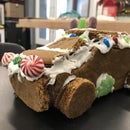Introduction: RoadBLOCK
Learning is a journey, with bumps in the road, but this block can help students overcome the roadblocks they face in education.
At school, I sometimes find it hard to ask questions in class. "Calling myself out" on a lack of understanding on the material is intimidating when it comes to raising my hand in front of everyone, and I know I am not the only one who feels that way about the subject.
That's where this block comes into play. It has faces that can be used to show confidence on subject material or even emotions, as socioemotional learning takes the center stage as we return to school from online learning. The top and bottom sides are dry-erasable, so students can write in their own faces, symbols, or words to represent their ideas and emotions. For instance, instead of raising their hand, a student could draw a question mark on the block, and once the teacher has run through the lesson, they can see and address the student's concern.
The block can also be used to answer questions. For instance, if a teacher gives a class a math question, everyone can answer it then hold their blocks up at once, allowing the teacher to see each student's knowledge of the material instead of calling each pupil individually.
I am a student at North Broward Preparatory School in the United States, and this is my entry for the 3D Printed Student Design Challenge.
Step 1: Prototype
This step isn't completely necessary, but it helped me get an idea of what my final design should and would look like. I used cardboard to make it because it is easy to work with, so I would not end up spending too long on this initial step.
Cut pieces of cardboard into six 2 in. x 2 in. squares and glue them together using hot glue. Once the cube has been formed, "draw on" the faces using the hot glue gun as a pen, filling in any shapes you make completely and letting them fully dry before turning the cube (Be careful not to burn yourself doing this!). Then, use pieces of tape to make the top sides dry-erasable (see step 9 for more information). Finally, go over the hot glue faces previously drawn on with a black permanent marker to make them more visible.
Step 2: Making the Base
Make a box using the “Create” tool & make its parameters 100 mm x 100 mm x 100 mm using the “Press Pull” tool
Step 3: Making Eyes
Add a new sketch and select one of the box’s faces as the plane
Create a “Diameter Circle” with a diameter of 28 mm and use the “Move/Copy” tool to center it in the upper left quadrant of the square plane
Use the same “Move/Copy” tool to duplicate it and create another circle centered in the upper right quadrant
Use the “Extrude” tool and select both circles then drag them 10 mm down
Step 4: Making the First Face
On the same plane as the eyes, create a new sketch and make a “Fit Point Spline” that resembles the bottom of a smiling mouth and add a line to join the two top ends of the first shape
Once again, extrude the shape 10 mm down
Step 5: Making the Second Face
If necessary, rotate the block towards the right by 90 degrees using the "move" tool
Repeat Step 3 to make a set of eyes on the next plane
Create a new sketch and make a “Fit Point Spline” that resembles the top of a frowning mouth and add a line to join the two top ends of the first shape
Finish the sketch and extrude it by -10 cm
Step 6: Making the Third Face
If necessary, rotate the block towards the right by 90 degrees using the "move" tool
Repeat Step 2 to make a set of eyes on the next plane
Use the steps from the last segment to create a less distinguished frown
Extrude the design -10 cm
Step 7: Making the Final Face
Make another set of eyes using the same method and use the steps from the last segment to create a less distinguished smile
Extrude the design -10 cm
Step 8: Printing!
Follow your CAD software & 3D printer's instructions to bring your block to life!
Step 9: Making It Dry-Erasable
Take strips of tape (I used clear Scotch tape, but play around with various types to find one that works for you) and put them on the top and bottom of the cube (the sides without faces), ensuring you do not leave empty space between the strips. The tape acts as a dry-erasable surface that can be replaced after repeated use!
Step 10: Finalizing
Thank you for taking the time to read through this Instructable! Any feedback is greatly appreciated, and I hope that these nifty little blocks can be implemented to help students feel more comfortable in class <3





